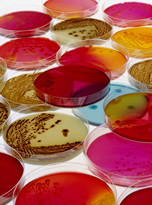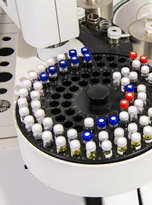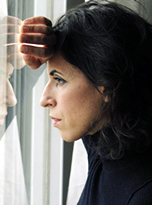Read and report vaccine reactions, harassment and failures.

Shingles: The Disease
Herpes zoster, also known as shingles, is an inflammation of nerves and the surrounding area of skin caused by Varicella Zoster (chickenpox) virus infection. Shingles usually occurs when the dormant Varicella Zoster virus is reactivated in an adult who has recovered from chickenpox as a child. Shingles most commonly occurs in individuals over 50 years of age. Today, after chickenpox vaccine has been widely used by children since 1995 and has interrupted natural circulation of the varicella zoster virus in the U.S. population, experts believe that half of Americans reaching 85 years of age will experience shingles at some point in their lifetime. Learn more about shingles…
Shingles Vaccine
There are two shingles vaccines licensed for use in the U.S.; Zostavax live attenuated vaccine by Merck and SHINGRIX, a genetically engineered and adjuvanted recombinant vaccine by GlaxoSmithKline Biologicals. Zostavax was discontinued in the U.S. in November 2020.
Zostavax live attenuated shingles vaccine, licensed in 2006, is a much more potent version of Varivax chickenpox vaccine containing 19,500 plaque forming units of Oka/Merck varicella zoster virus versus 1,350 plaque forming units in the chickenpox vaccine. According to the CDC, Zostavax vaccine reduced shingles by about half (51%) in adults 60 years and older.
SHINGRIX adjuvanted recombinant vaccine, licensed in 2017, is a two-dose series vaccine administered intramuscularly (injected into muscle) and is a genetically engineered vaccine. SHINGRIX is reported to be over 90 percent effective, but no test is available to determine immunity to shingles and long-term vaccine effectiveness is unknown; Learn more about shingles vaccine…
Shingles Quick Facts
Shingles
- Herpes zoster (shingles) is a viral infection caused by the Varicella Zoster (chicken pox) virus. Individuals suffering with shingles cannot transmit shingles to others. However, someone, who has not already recovered from chickenpox disease, can get chickenpox from a person with shingles. This is believed to be from direct contact with the shingles lesions.
- Symptoms of shingles include pain, itching or tingling of areas of the skin, usually on the trunk of the body, along with fever, headache, chills and an upset stomach; Continue reading quick facts…
Shingles Vaccine
- There are two vaccines licensed in the U.S.: Zostavax, a live virus vaccine, licensed in 2006 and manufactured by Merck and SHINGRIX, a genetically engineered recombinant, adjuvanted vaccine, licensed in 2017 and manufactured by GlaxoSmithKline Biologicals. Zostavax was discontinued in the U.S. in November 2020.
- Using the MedAlerts search engine, as of March 29, 2024, there have been 122,065 reports of shingles vaccine reactions, hospitalizations, injuries and deaths following shingles vaccinations made to the federal Vaccine Adverse Events Reporting System (VAERS), including 477 related deaths, 5,082 hospitalizations, and 2,816 related disabilities. Continue reading quick facts…
NVIC encourages you to become fully informed about Shingles and the Shingles vaccine by reading all sections in the table of contents, which contain many links and resources such as the manufacturer product information inserts, and to speak with one or more trusted health care professionals before making a vaccination decision for yourself or your child. This information is for educational purposes only and is not intended as medical advice.
What is Shingles?

Herpes zoster, also known as shingles, is an inflammation of nerves and the surrounding area of skin caused by varicella zoster (chickenpox) virus infection.1 Shingles usually occurs when the dormant varicella zoster virus is reactivated in an adult who has recovered from chickenpox as a child.2
A painful rash most often begins on one side of the face or body and progresses to form blisters that usually scab over in seven to ten days. One to five days before the rash appears, there is often pain, itching or tingling in the areas where the rash later develops. Other symptoms of shingles can include fever, headache, chills and an upset stomach. Shingles typically clears up within two to four weeks.3
Individuals who have experienced and recovered from natural chickenpox as children usually have only one bout with shingles in their lifetime. However, in rare cases a second or even a third episode has been reported.4
Scientists do not understand the biological mechanisms underlying reactivation of varicella zoster infection, but risk factors are thought to include aging, auto-immune disorders, immunosuppression, and stress.5 6 Other populations at risk for developing shingles are those with weakened immune systems due to HIV/AIDS or other diseases that affect healthy immune function. Drugs used for organ transplants and cancer treatment can also increase the risk of shingles.7
Shingles most commonly occurs in individuals over 50 years of age.8 Today, after chickenpox vaccine has been widely used by children since 1995 and has interrupted natural circulation of the varicella zoster virus in the U.S. population,9 experts believe that half of Americans reaching 85 years of age will experience shingles at some point in their lifetime.10
What causes shingles?
The same varicella zoster virus that causes chickenpox causes herpes zoster (shingles) disease.11 Individuals who recover from chickenpox usually acquire long lasting immunity to chickenpox.12 After recovery from chickenpox, the varicella zoster virus becomes dormant (inactive) and immunity to chickenpox is asymptomatically boosted when adults come into contact with children who have chickenpox. However, for reasons that doctors do not fully understand, in some individuals the dormant varicella zoster virus becomes active again and causes shingles.13
Individuals suffering with shingles cannot transmit shingles to others. However, someone who has not already recovered from chickenpox disease can get chickenpox from a person with shingles.14 Herpes zoster is not caused by Herpes simplex Types 1 and 2 associated with cold sores and sexually transmitted genital herpes.15
IMPORTANT NOTE: NVIC encourages you to become fully informed about Shingles and the Shingles vaccine by reading all sections in the Table of Contents , which contain many links and resources such as the manufacturer product information inserts, and to speak with one or more trusted health care professionals before making a vaccination decision for yourself or your child. This information is for educational purposes only and is not intended as medical advice.
Is Shingles Contagious?

Shingles is not contagious and cannot be passed from person to person. It is the result of reactivation of the virus that causes chickenpox (varicella zoster virus – VZV). Reactivation of this virus is what causes shingles in people who have previously had chickenpox. However, VZV can be spread from a person with active shingles to another person who has never had chickenpox. This happens when the shingles rash is in the blister-phase and the fluid from the blisters comes into direct contact with a person.1
Persons exposed to VZV virus from someone with an active shingles infection might develop chickenpox, but they would not develop shingles. Shingles is not as contagious as chickenpox and the risk of spreading infection is decreased when the rash is covered. When the blisters from shingles develop crusts the risk of infecting others has passed.2
You can prevent the spread of VZV to others by:3
- Keeping the rash covered;
- Refraining from scratching or touching the rash;
- Frequent hand washing;
- Avoiding contact with people until rash has crusted over.
IMPORTANT NOTE: NVIC encourages you to become fully informed about Shingles and the Shingles vaccine by reading all sections in the Table of Contents , which contain many links and resources such as the manufacturer product information inserts, and to speak with one or more trusted health care professionals before making a vaccination decision for yourself or your child. This information is for educational purposes only and is not intended as medical advice.
What is the history of Shingles in America and other countries?

Herpes zoster (shingles) and herpes simplex were named by Hippocrates, who initially described the ulcerative skin rashes. Herpes zoster, however, differed from herpes simplex, as it was noted to present as a line of painful blisters along the nerves, on one side of the body. Celsus (25 BC – c. 50 AD) was the first to use the term Zoster, from the Latin and Greek word for belt. The word Shingles came from the medieval Latin word “cingulus” which means “girdle”, and referred to the lesions typically found around the waist.1
Chickenpox and shingles were investigated independently for many years. Richard Bright hypothesized that shingles originated in the nervous system in 1831. In 1863, Von Barensprung suggested that shingles was found in the sensory ganglia, as lesions appeared to correspond with spinal nerves. By the 20th century, Campbell and Head had determined that the features of shingles consisted of inflammation and necrosis of the ganglion cells in the posterior ganglion root. It was still not yet known what caused shingles.2
In 1892, Von Bókay initially suggested a relationship between chickenpox and shingles after noting the presence of both illnesses in the same household at the same time. He also reported that the skin lesions appeared to be similar in nature. In 1923, de Lange reported the presence of antibodies to chickenpox in all patients who developed shingles.3
Additional studies were conducted on human subjects. These experiments reported that persons injected with the vesicular fluid from shingles lesions developed a rash identical to what was seen in persons with chickenpox. The invention of the electron microscope allowed scientists to further examine fluid from shingles and chickenpox and found them both to be indistinguishable at an ultrastructural level.4
In 1965, Hope-Simpson hypothesized that shingles was due to the reactivation of a latent virus and that exposure to the virus would prevent this from occurring. He also postulated that reactivation occurred when antibody levels fell below what was necessary to stop this from happening.5 It is now believed that a decline in cell-mediated immune response also plays a role in the development of shingles.6
Is there an association between chickenpox vaccine and an increase in shingles?
In 2005, Gary Goldman, PhD, was among the first researchers to publish an analysis of the mass use of chickenpox vaccine by children in the U.S. since 1995. His conclusion was that, by limiting the circulation of wild type Varicella Zoster virus in the population through mass vaccination, there is limited asymptomatic boosting of natural chickenpox immunity among adults, who had recovered from chickenpox as children. This would, in turn, cause an epidemic of shingles.7
In 2008 the Health Protection Agency (HPA), an independent organization formed by the government of the United Kingdom in 2003, published new modeling that confirmed that mass use of chickenpox vaccine would lead to an increase in shingles despite the shingles vaccine.8
The HPA estimated that, while mass vaccination would reduce the incidence of chickenpox in children, there was an over 20 percent projected increase in the incidence of shingles in adults. The HPA confirmed that this projected increase in shingles is because adults are no longer coming in contact with natural chickenpox cases due to vaccine acquired immunity among children. In addition, studies from countries that routinely vaccinate children against chickenpox, such as the U.S., demonstrate that there is an increase in shingles in unvaccinated persons, who have not had chickenpox or the chickenpox vaccine.9
A study in 2002 confirmed that adults exposed to natural chickenpox disease were protected from developing shingles and that there is concern that mass vaccination against chickenpox will cause future epidemics of shingles among more than 50 percent of Americans aged 10 to 44 years.10
There are also reports that young children and teenagers who have gotten chickenpox vaccine are also experiencing shingles.11
Shingles in the United States
The CDC estimates that one million Americans develop shingles each year and the incidence of the illness is about four cases per 1,000 U.S. population yearly. In adults 60 and older, the rate is estimated at one case per 100 U.S. population. The CDC also estimates that 96 shingles-related deaths occur yearly.12
IMPORTANT NOTE: NVIC encourages you to become fully informed about Shingles and the Shingles vaccine by reading all sections in the Table of Contents , which contain many links and resources such as the manufacturer product information inserts, and to speak with one or more trusted health care professionals before making a vaccination decision for yourself or your child. This information is for educational purposes only and is not intended as medical advice.
Can Shingles Cause Injury and/or Death?

Shingles is a painful rash that usually begins on one side of the body or face. If it occurs on the face, shingles can affect the eye and cause vision impairments.1
The most common complications of shingles is post herpetic neuralgia (PHN) that involves a longer period of nerve inflammation. PHN symptoms include severe pain where the shingles rash appeared after the rash clears up. PHN can be debilitating and can lasts for weeks to months. However, in rare cases, the chronic nerve inflammation and pain can persist for years. Older adults are at a higher risk for PHN, with the pain being more severe.2
Shingles can also lead to hearing and balance problems, facial paralysis, pneumonia, brain inflammation (encephalitis) and death.3
IMPORTANT NOTE: NVIC encourages you to become fully informed about Shingles and the Shingles vaccine by reading all sections in the Table of Contents , which contain many links and resources such as the manufacturer product information inserts, and to speak with one or more trusted health care professionals before making a vaccination decision for yourself or your child. This information is for educational purposes only and is not intended as medical advice.
Who is at highest risk for getting Shingles?

Scientists do not understand the biological mechanisms underlying reactivation of varicella zoster infection, but risk factors are thought to include aging, auto-immune disorders, immunosuppression, and stress.1 2 Other populations at risk for developing shingles are those with weakened immune systems due to HIV/AIDS or other diseases that affect healthy immune function. Drugs used for organ transplants and cancer treatment can also increase the risk of shingles.3
Individuals who have had the chickenpox can develop shingles and the CDC estimates that in the U.S., one out of three people will develop shingles in their lifetime. The risk of shingles increases after age 50, and half of all people who live to age 85 will have shingles in their lifetime.4
Caucasians are about fifty percent more likely than Blacks to develop shingles and more cases occur in women. In the U.S., it is estimated that a million shingles cases occur annually, with an incidence rate of approximately four cases per 1000 U.S. population each year. Most people who develop shingles will only have one episode, however, it is possible for individuals to develop shingles a second or third time.5
IMPORTANT NOTE: NVIC encourages you to become fully informed about Shingles and the Shingles vaccine by reading all sections in the Table of Contents , which contain many links and resources such as the manufacturer product information inserts, and to speak with one or more trusted health care professionals before making a vaccination decision for yourself or your child. This information is for educational purposes only and is not intended as medical advice.
Who is at highest risk for suffering complications from Shingles?

Most healthy people who develop shingles and get treatment quickly after an outbreak will experience a cessation of pain within five weeks and the blisters will leave no scars. Individuals at highest risk for complications are immunosuppressed individuals, e.g. - organ transplant recipients, HIV infected, and individuals receiving cancer treatments that weaken the immune system.1
The most common complication experienced from shingles, postherpetic neuralgia (PHN), resolves within a few weeks or months after infection. PHN occurs after the rash disappears and is a persistent pain in the areas where the shingles rash appeared. In rare cases, pain from PHN can interfere with daily life for many years. According to the CDC, the risk for PHN from a shingles infection increases with age and it is estimated that 13 percent of shingles cases in persons age 60 and older will experience PHN, while being rare in cases where persons are under the age of 40.2
Other serious complications can involve the eye and result in loss of vision. Rare complications include pneumonia, hearing problems, blindness, brain inflammation (encephalitis), and death.3
IMPORTANT NOTE: NVIC encourages you to become fully informed about Shingles and the Shingles vaccine by reading all sections in the Table of Contents , which contain many links and resources such as the manufacturer product information inserts, and to speak with one or more trusted health care professionals before making a vaccination decision for yourself or your child. This information is for educational purposes only and is not intended as medical advice.
Can Shingles be prevented and are there treatment options?

Antiviral medicines, such as acyclovir, valacyclovir, and famciclovir are reported to shorten the length and severity of the illness and are most effective when started as soon as possible after the rash appears. Pain medication may also help to relieve the pain caused by shingles. Itching associated with shingles, like with chickenpox, can be relieved by using wet compresses and anti-itch products like calamine lotion and colloidal oatmeal baths.
IMPORTANT NOTE: NVIC encourages you to become fully informed about Shingles and the Shingles vaccine by reading all sections in the Table of Contents , which contain many links and resources such as the manufacturer product information inserts, and to speak with one or more trusted health care professionals before making a vaccination decision for yourself or your child. This information is for educational purposes only and is not intended as medical advice.
What is Shingles Vaccine?

There are two shingles vaccines licensed for use in the U.S.; Zostavax live attenuated vaccine by Merck and SHINGRIX recombinant vaccine by GlaxoSmithKline Biologicals. The use of Zostavax was discontinued in the U.S. in November 2020.1
SHINGRIX adjuvanted recombinant vaccine licensed in 2017 is a two-dose series vaccine administered intramuscularly (injected into muscle). This vaccine is genetically engineered and contains sucrose, sodium chloride, dioleoyl phosphatidylcholine (DOPC), potassium dihydrogen phosphate, cholesterol, sodium dihydrogen phosphate dihydrate, disodium phosphate anhydrous, dipotassium phosphate, polysorbate 80, Chinese Hamster Ovary (CHO) cell proteins, and DNA.2 This vaccine uses AS01B, a novel adjuvant system, that contains both QS-21 Stimulon and MPL (monophosphyoryl lipid a). QS-21 Stimulon is a purified extract from the bark of the Quillaja saponaria vergreen, or soap bark tree.3 It is designed to enhance the “turbocharge vaccines by strengthening and broadening immune responses (both T cell and antibody mediated) to a vaccine’s antigens.”4 MPL is an immune-stimulating fat.5
Zostavax live attenuated shingles vaccine licensed in 2006 is a much more potent version of Varivax chickenpox vaccine containing 19,500 plaque forming units of Oka/Merck varicella zoster virus versus 1,350 plaque forming units in the chickenpox vaccine.6 This vaccine is administered subcutaneously as a one-dose shot and contains sucrose, hydrolyzed porcine (pig) gelatin, urea (urine component), sodium chloride, monosodium L-glutamate, sodium phosphate dibasic, potassium phosphate monobasic, potassium chloride, MRC-5 cells (1966 aborted human male lung tissue)7, neomycin and bovine (cow) calf serum (blood plasma).8 9
IMPORTANT NOTE: NVIC encourages you to become fully informed about Shingles and the Shingles vaccine by reading all sections in the Table of Contents , which contain many links and resources such as the manufacturer product information inserts, and to speak with one or more trusted health care professionals before making a vaccination decision for yourself or your child. This information is for educational purposes only and is not intended as medical advice.
What is the history of Shingles vaccine in America and other countries?

The first shingles (herpes zoster) vaccine, Zostavax, received approval for use by the U.S. Food and Drug Administration (FDA) in 2006.1 2 Zostavax, manufactured by Merck, was initially licensed for use as a single dose vaccine to be administered to healthy Americans age 60 years and older, without immune system disorders. This vaccine was a much more potent version of the Varivax chicken pox vaccine.3 In 2011, the FDA expanded Zostavax use to include Americans age 50 to 59.4
In 2017, SHINGRIX, a new genetically engineered, adjuvanted, recombinant vaccine manufactured by GlaxoSmithKline, was approved by the FDA for use in healthy adults age 50 and older. The CDC gave preference to the use of SHINGRIX over Zostavax, except in cases where individuals had an allergic reaction to SHINGRIX, in October 2017.5
Shingles vaccine is one of the few vaccines not covered by the National Childhood Vaccine Injury Act of 1986, which means individual may sue the vaccine manufacturer directly for vaccine injuries associated with the vaccine. Merck, the manufacturer for Zostavax, is currently in litigation and defending itself against lawsuits that allege the vaccine caused serious side-effects, including death. 6 In December 2022, a Pennsylvania Federal Judge dismissed nearly 1,200 claims alleging shingles after Zostavax vaccine. The claims were reportedly thrown out by the judge due to a lack of proof that the shingles rash was related to the vaccine. Additional lawsuits alleging both auto-immune disorders and hearing loss are pending.7 Merck discontinued sales of Zostavax in the U.S. in November 2020.8
On March 24, 2021, the FDA announced that it was requiring a new warning on the SHINGRIX package insert about an increased risk of Guillain Barré Syndrome within 42 days of vaccine administration. According to the FDA:9
“The risk of GBS following vaccination with Shingrix was assessed in self-controlled case series analyses using a risk window of 1 to 42 days post-vaccination and a control window of 43 to 183 days post-vaccination. The primary analysis (claims-based, all doses) found an increased risk of GBS during the 42 days following vaccination with Shingrix, with an estimated 3 excess cases of GBS per million doses administered to adults aged 65 years or older. In secondary analyses, an increased risk of GBS was observed during the 42 days following the first dose of Shingrix, with an estimated 6 excess cases of GBS per million doses administered to adults aged 65 years or older, and no increased risk of GBS was observed following the second dose of Shingrix. These analyses of GBS diagnoses in claims data were supported by analyses of GBS cases confirmed by medical record review.”
The FDA, however, reports that the benefits of SHINGRIX vaccine outweigh the risk.
In July 2021, the FDA approved the SHINGRIX vaccine for immunocompromised individuals 19 years and older. The CDC’s ACIP voted to recommend 2 doses of the vaccine for this population in October 2021.10
IMPORTANT NOTE: NVIC encourages you to become fully informed about Shingles and the Shingles vaccine by reading all sections in the Table of Contents , which contain many links and resources such as the manufacturer product information inserts, and to speak with one or more trusted health care professionals before making a vaccination decision for yourself or your child. This information is for educational purposes only and is not intended as medical advice.
How effective is Shingles vaccine?

According to the U.S. Centers for Disease Control (CDC), SHINGRIX vaccine is estimated to reduce shingles by over 90 percent in adults 50 years and older. The length of protection from SHINGRIX past 4 years is unknown.
Zostavax shingles vaccine, which is no longer available for use in the U.S. as of November 2020, was estimated to be 51 percent effective at reducing the risk of shingles in adults 60 years of age and older. The Zostavax manufacturer package insert states: “Vaccination with Zostavax does not result in protection of all vaccine recipients. The duration of protection beyond 4 years after vaccination with Zostavax is unknown. The need for revaccination has not been defined.” However, efficacy studies showed a significant decrease in vaccine effectiveness one year post-vaccination and by nine years, Zostavax was determined to be no longer effective at preventing shingles.
IMPORTANT NOTE: NVIC encourages you to become fully informed about Shingles and the Shingles vaccine by reading all sections in the Table of Contents , which contain many links and resources such as the manufacturer product information inserts, and to speak with one or more trusted health care professionals before making a vaccination decision for yourself or your child. This information is for educational purposes only and is not intended as medical advice.
Can Shingles vaccine cause injury and death?

According to the SHINGRIX vaccine package insert, adverse events reported during clinical trial included pain, swelling and redness at the injection site; headache; fever; fatigue; shivering; gastrointestinal issues; gout; and optic ischemic neuropathy.
GlaxoSmithKline committed to various post marketing studies for the SHINGRIX vaccine licensed in 2017. According to data presented by the CDC during the June 2018 Advisory Committee on Immunization Practices (ACIP) meeting, since its licensure in October of 2017 to April of 2018 there were 680 reaction reports submitted to the federal Vaccine Adverse Event Reporting System (VAERS), with no unusual or unexpected patterns and events. The majority of reports were in females and were not serious events, with the most common reaction being injection site pain.
At the February 2019 ACIP meeting, the CDC's Dr. Tom Shimabukuro of the Immunization Safety Office (ISO) reported on a potential safety signal with SHINGRIX vaccine. An association between Guillain Barre Syndrome (GBS) and the vaccine had been found in the Vaccine Safety Datalink (VSD) and the Vaccine Adverse Events Reporting System (VAERS). GBS is a rare neurological disorder that causes inflammation of the peripheral nerves. Complications can include temporary or chronic paralysis, including full body paralysis.
The CDC, FDA, and the Centers for Medicare and Medicaid Services (CMS) conducted a review of data from the Medicare claims database. According to the FDA:
“The risk of GBS following vaccination with Shingrix was assessed in self-controlled case series analyses using a risk window of 1 to 42 days post-vaccination and a control window of 43 to 183 days post-vaccination. The primary analysis (claims-based, all doses) found an increased risk of GBS during the 42 days following vaccination with Shingrix, with an estimated 3 excess cases of GBS per million doses administered to adults aged 65 years or older. In secondary analyses, an increased risk of GBS was observed during the 42 days following the first dose of Shingrix, with an estimated 6 excess cases of GBS per million doses administered to adults aged 65 years or older, and no increased risk of GBS was observed following the second dose of Shingrix. These analyses of GBS diagnoses in claims data were supported by analyses of GBS cases confirmed by medical record review.”
The FDA determined an association between SHINGRIX and GBS but reported that the current data was not available to establish a causal relationship. They did, however, conclude that a revision to the Warnings and Precautions section of the SHINGRIX package insert on the risk of GBS was warranted.
Additional adverse events reported after SHINGRIX vaccine licensure included allergic reactions, angioedema, urticaria, and rash; and decreased mobility in the arm where the vaccine was administered.
Adverse events reported in clinical trials or post-marketing of Zostavax shingles vaccine include pain, swelling and redness at the injection site; headache; zoster-like skin rash; fever; shock; joint and muscle pain; swollen glands; and respiratory symptoms. Optic neuritis following Zostavax vaccine has also been reported in a published case study.
The Zostavax package insert states that transmission of vaccine virus may occur between vaccines and susceptible contacts.
, i.e. - the vaccinated individual is contagious with vaccine strain chickenpox and can infect others with chickenpox, if they have not previously had chickenpox.
Merck, the manufacturer for Zostavax, is currently defending itself against 60 lawsuits that allege the vaccine caused serious side-effects, including death. The outcome of these proceedings is pending. Sales of Zostavax in the U.S. were discontinued in November 2020.
Using the MedAlerts search engine, as of March 29, 2024 there have been 122,065 reports of shingles vaccine reactions, hospitalizations, injuries and deaths following shingles vaccinations made to the federal Vaccine Adverse Events Reporting System (VAERS), including 477 related deaths, 5,082 hospitalizations, and 2,816 related disabilities.
Shingles vaccine is one of the few vaccines not covered by the National Childhood Vaccine Injury Act of 1986, which means individual may sue the vaccine manufacturer directly for vaccine injuries associated with the vaccine. Merck, the manufacturer for Zostavax, is currently in litigation and defending itself against lawsuits that allege the vaccine caused serious side-effects, including death. In December 2022, a Pennsylvania Federal Judge dismissed nearly 1,200 claims alleging shingles after Zostavax vaccine. The claims were reportedly thrown out by the judge due to a lack of proof that the shingles rash was related to the vaccine. Additional lawsuits alleging both auto-immune disorders and hearing loss are pending.
IMPORTANT NOTE: NVIC encourages you to become fully informed about Shingles and the Shingles vaccine by reading all sections in the Table of Contents , which contain many links and resources such as the manufacturer product information inserts, and to speak with one or more trusted health care professionals before making a vaccination decision for yourself or your child. This information is for educational purposes only and is not intended as medical advice.
Who is at highest risk for complications from Shingles vaccine?

Persons who are allergic to any ingredient of the SHINGRIX vaccine, or a previous vaccine dose, and who receive a dose of the vaccine are at high risk of complications. Additionally, persons vaccinated with SHINGRIX while ill with shingles, or with another illness may also be at high risk for complications. Persons who have no prior history of chickenpox and women who are pregnant or breastfeeding may also be at high of complications by receiving SHINGRIX vaccination.1
Individuals who are allergic to any of the ingredients of ZOSTAVAX such as gelatin, or neomycin, are at risk of complications if they receive the vaccine. Persons who are immunocompromised or immune suppressed, and pregnant and breastfeeding women are also at risk of complication by receiving ZOSTAVAX vaccine.2
IMPORTANT NOTE: NVIC encourages you to become fully informed about Shingles and the Shingles vaccine by reading all sections in the Table of Contents , which contain many links and resources such as the manufacturer product information inserts, and to speak with one or more trusted health care professionals before making a vaccination decision for yourself or your child. This information is for educational purposes only and is not intended as medical advice.
Who should not get Shingles vaccine?

SHINGRIX1 and Zostavax2 vaccines for shingles are licensed for use in healthy adults over age 50. SHINGRIX is also licensed for use in persons 18 years and older who are immunocompromised.3
In 2018, the CDC recommended that all adults over 50 years of age receive two doses of SHINGRIX vaccine. SHINGRIX was recommended over Zostavax despite unknown long-term serious side effects and long-term effectiveness.4 Zostavax was discontinued in the U.S. in November 2020.5
Individuals who have a history of severe allergic reactions to any component of the vaccine or to a previous dose of the vaccine should not receive SHINGRIX vaccine.6 Pregnant or breastfeeding women, persons who currently have a shingles infection, and individuals who are moderately or severely ill should not receive SHINGRIX or should wait until illness symptoms have resolved.7 There are no studies on the safety or effectiveness of administering SHINGRIX vaccine less than 5 years after receipt of Zostavax shingles vaccine.8
According to the Zostavax vaccine package insert, individuals who have had a previous life-threatening or severe allergic reaction to gelatin or the antibiotic neomycin, those who are immunosuppressed or immune deficient, and pregnant women should not receive Zostavax vaccine. Pregnancy should be avoided for 3 months following administration of Zostavax. Persons who are acutely ill or those with tuberculous should defer Zostavax vaccination until healthy.9
IMPORTANT NOTE: NVIC encourages you to become fully informed about Shingles and the Shingles vaccine by reading all sections in the Table of Contents , which contain many links and resources such as the manufacturer product information inserts, and to speak with one or more trusted health care professionals before making a vaccination decision for yourself or your child. This information is for educational purposes only and is not intended as medical advice.
What questions should I ask my doctor about the Shingles vaccine?

NVIC’s If You Vaccinate, Ask 8! Webpage and downloadable brochure suggests asking eight questions before you make a vaccination decision for yourself, or for your child. If you review these questions before your appointment, you will be better prepared to ask your doctor questions. Also make sure that the nurse or doctor gives you the relevant Vaccine Information Statement (VIS) for the vaccine or vaccines you are considering well ahead of time to allow you to review it before you or your child gets vaccinated. Copies of the VIS for each vaccine are also available on the CDC's website and there is a link to the shingles VIS in NVIC’s shingles “Quick Facts” section.
It is also a good idea to read the vaccine manufacturer product insert that can be obtained from your doctor or public health clinic because federal law requires drug companies marketing vaccines to include certain kinds of vaccine benefit, risk and use information in product information inserts that may not be available in other published information. NVIC also provides this information in our shingles Quick Facts section.
Other questions that may be useful to discuss with your doctor before getting the shingles vaccine are:
- If other vaccines in addition to shingles vaccine are scheduled at this office visit, am I allowed to modify the schedule so fewer vaccines are given at once?
- What should I do if I have a high fever or get very ill after vaccination?
- What other kinds of reaction symptoms should I call to report after shingles vaccination?
- If the shingles vaccine doesn’t protect me, do I have any other options for preventing shingles infection?
While shingles vaccines are not covered under the National Childhood Vaccine Injury Act of 1986 and not eligible for federal vaccine injury compensation, doctors and all vaccine providers should provide you with risk and benefit information on shingles and shingles vaccine before vaccination. They should also record serious health problems following vaccination in the permanent medical record; keep a permanent record of all vaccines given, including the manufacturer’s name and lot number; and report serious health problems, injuries and deaths that follow vaccination to VAERS and you have a right to receive that same information from all vaccine providers.
IMPORTANT NOTE: NVIC encourages you to become fully informed about Shingles and the Shingles vaccine by reading all sections in the Table of Contents , which contain many links and resources such as the manufacturer product information inserts, and to speak with one or more trusted health care professionals before making a vaccination decision for yourself or your child. This information is for educational purposes only and is not intended as medical advice.
NVIC Press Releases, Statements & Commentaries Related to Shingles
NVIC Press Releases, Statements and Commentaries
- NVIC Press Release: NVIC Challenges VAERS Data of Chickenpox Vaccine Adverse Events. Sept. 13, 2000.
- NVIC Referenced Report: The Emerging Risks of Live Virus & Virus Vectored Vaccines: Vaccine Strain Virus Infection, Shedding & Transmission. 2014.
The Vaccine Reaction
- Hendler C. Shingles May Be Triggered by Covid Shots. Dec. 26, 2022.
- Dwoskin C Merck Admits Shingles Vaccine Can Cause Eye Damage… and Shingles The Vaccine Reaction Sept. 1, 2016.
- Raines K New Supercharged Shingles Vaccine Has Serious Problems The Vaccine Reaction Sept. 4, 2018.
- Mercola J Is the Chickenpox Vaccine Creating a Shingles Epidemic? The Vaccine Reaction Dec. 20, 2018.
- Raines K, Fisher BL CDC Accused of Manipulating Shingles Data The Vaccine Reaction Aug. 19, 2018.
- Raines K Chickenpox Vaccine May Increase Shingles Risk The Vaccine Reaction Apr. 26, 2016.
- Raines K Merck Sued Over Zostavax-Related Injury The Vaccine Reaction Sept. 20, 2018.
- Raines K When Vaccination Status Creates a Treatment Dilemma The Vaccine Reaction May 19, 2015.
IMPORTANT NOTE: NVIC encourages you to become fully informed about Shingles and the Shingles vaccine by reading all sections in the Table of Contents , which contain many links and resources such as the manufacturer product information inserts, and to speak with one or more trusted health care professionals before making a vaccination decision for yourself or your child. This information is for educational purposes only and is not intended as medical advice.
Additional Bibliography of References
Articles
- Latest HPA modeling reveals chickenpox vaccination would lead to more shingles among elderly despite introduction of shingles vaccination - September 2008
- Chicken Pox Vaccine Associated with Shingles Epidemic - September 2005
IMPORTANT NOTE: NVIC encourages you to become fully informed about Shingles and the Shingles vaccine by reading all sections in the Table of Contents , which contain many links and resources such as the manufacturer product information inserts, and to speak with one or more trusted health care professionals before making a vaccination decision for yourself or your child. This information is for educational purposes only and is not intended as medical advice.
Herpes Zoster (Shingles) & Shingles vaccine quick facts

Shingles
- Herpes zoster (shingles) is a viral infection caused by the varicella zoster (chicken pox) virus. Shingles involves inflammation of the nerves and a very painful blistering skin rash that typically lasts two to four weeks. Herpes zoster is not caused by Herpes simplex Types 1 and 2 associated with cold sores and sexually transmitted genital herpes.
- Symptoms of shingles include pain, itching or tingling of areas of the skin, usually on the trunk of the body, along with fever, headache, chills and an upset stomach. Complications of shingles include post-herpatic neuralgia (chronic nerve pain), loss of vision, hearing problems, brain inflammation (encephalitis), Bell’s Palsy, pneumonia and, rarely, death;
- Individuals suffering with shingles cannot transmit shingles to others. However, someone who has not already recovered from chickenpox disease can get chickenpox from a person with shingles. This is believed to be from direct contact with the shingles lesions.
- Herpes zoster is most common in individuals over 50 years of age , however, individuals who are immunocompromised or who take medications that suppress the immune system are at higher risk.
- Treatment with antivirals may shorten the time it takes to recover from shingles. Over the counter or prescription pain medication may help to relieve pain and calamine lotion, colloidal oatmeal baths, and wet compresses may assist with itching.
Shingles Vaccine
- There are two vaccines licensed in the U.S.: Zostavax, a live virus vaccine, licensed in 2006 and manufactured by Merck and SHINGRIX, a genetically engineered recombinant, adjuvanted vaccine, licensed in 2017 and manufactured by GlaxoSmithKline Biologicals. Zostavax was discontinued in the U.S. in November 2020. Shingles vaccination is currently recommended for all persons age 50 and older and for individuals 19 years and older who are immunocompromised.
- Reported complications from SHINGRIX vaccine include swelling, pain and redness at the injection site, headache, muscle pain, shivering, fatigue, gout (including gouty arthritis), optic ischemic neuropathy and Guillain-Barré syndrome. Reported complications from Zostavax vaccine include local swelling, pain and redness at injection site; zoster-like skin rash, headache, joint pain, muscle pain, fever, abnormally swollen glands, and hypersensitivity reactions including anaphylaxis (shock).
- Zostavax vaccine effectiveness is reported to be about 51 percent while SHINGRIX is reported to be over 90 percent effective. There is no available test to determine immunity to shingles and long-term vaccine effectiveness is unknown.
- Zostavax vaccine contains live attenuated varicella zoster virus and vaccine strain virus transmission of chickenpox from the vaccinated to susceptible individuals has been reported. Mass use of chickenpox vaccine by children in the U.S. since 1995 has limited natural boosting of Varicella Zoster immunity in the adult population and there has been a significant increase in cases of Herpes zoster among adults.
- Using the MedAlerts search engine, as of March 29, 2024 there have been 122,065 reports of shingles vaccine reactions, hospitalizations, injuries and deaths following shingles vaccinations made to the federal Vaccine Adverse Events Reporting System (VAERS), including 477 related deaths, 5,082 hospitalizations, and 2,816 related disabilities.
Food & Drug Administration (FDA)
- Zoster Vaccine, Live, Product Insert & Licensing Information and FDA on Zostavax
- Zoster Vaccine Recombinant, Adjuvanted Product Insert & Licensing Information
Centers for Disease Control (CDC)
Search for Vaccine Reactions
NVIC is proud to host MedAlerts, a powerful VAERS database search engine. MedAlerts examines symptoms, reactions, vaccines, dates, places, and more.
Reporting a Vaccine Reaction
Since 1982, the NVIC has operated a Vaccine Reaction Registry, which has served as a watchdog on VAERS. Reporting vaccine reactions to VAERS is the law. If your doctor will not report a reaction, you have the right to report a suspected vaccine reaction to VAERS.
Vaccine Reaction Symptoms & Ingredients
Our Ask 8, If You Vaccinate webpage contains vaccine reaction symptoms and more.
IMPORTANT NOTE: NVIC encourages you to become fully informed about Shingles and the Shingles vaccine by reading all sections in the Table of Contents , which contain many links and resources such as the manufacturer product information inserts, and to speak with one or more trusted health care professionals before making a vaccination decision for yourself or your child. This information is for educational purposes only and is not intended as medical advice.



